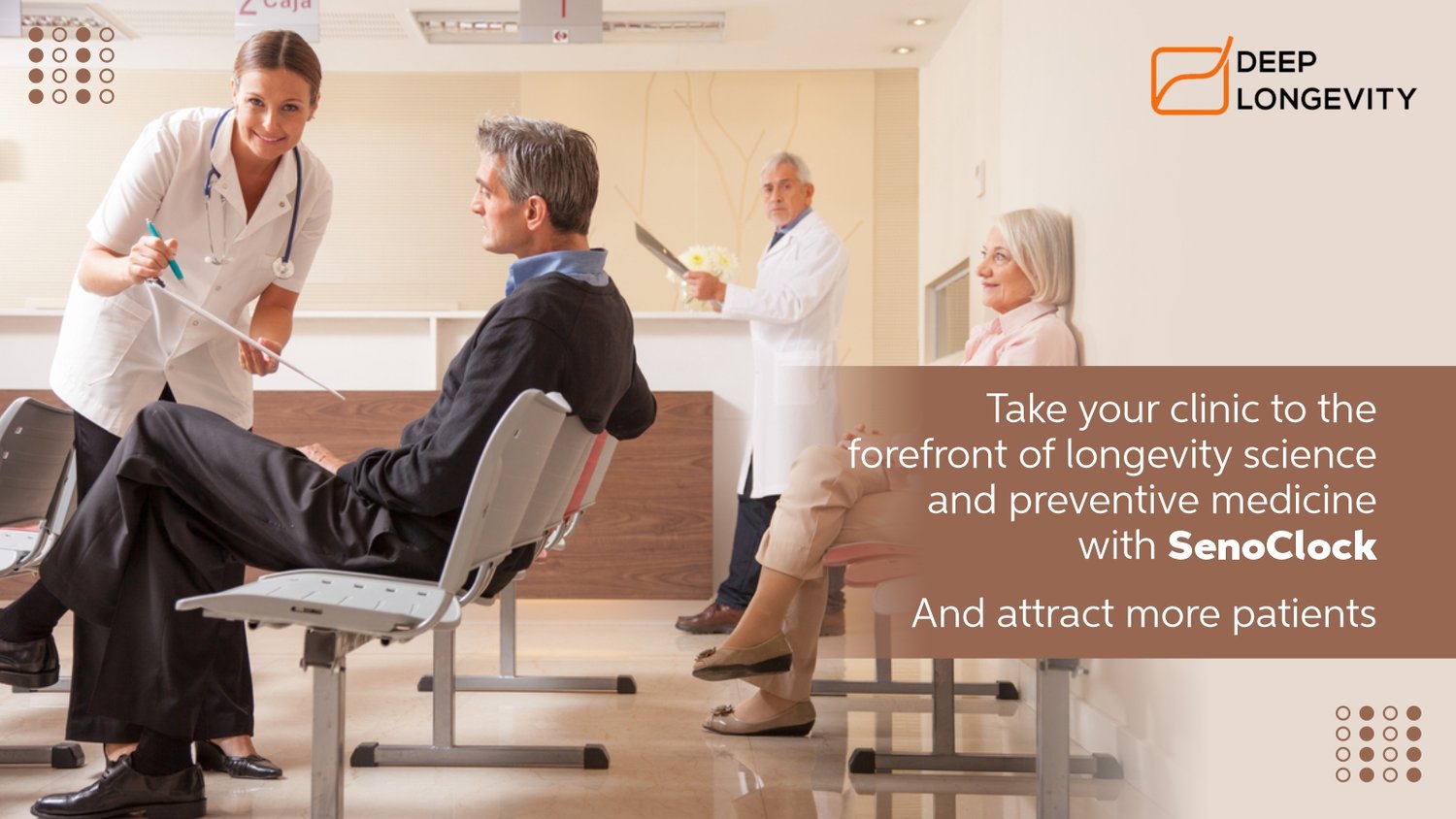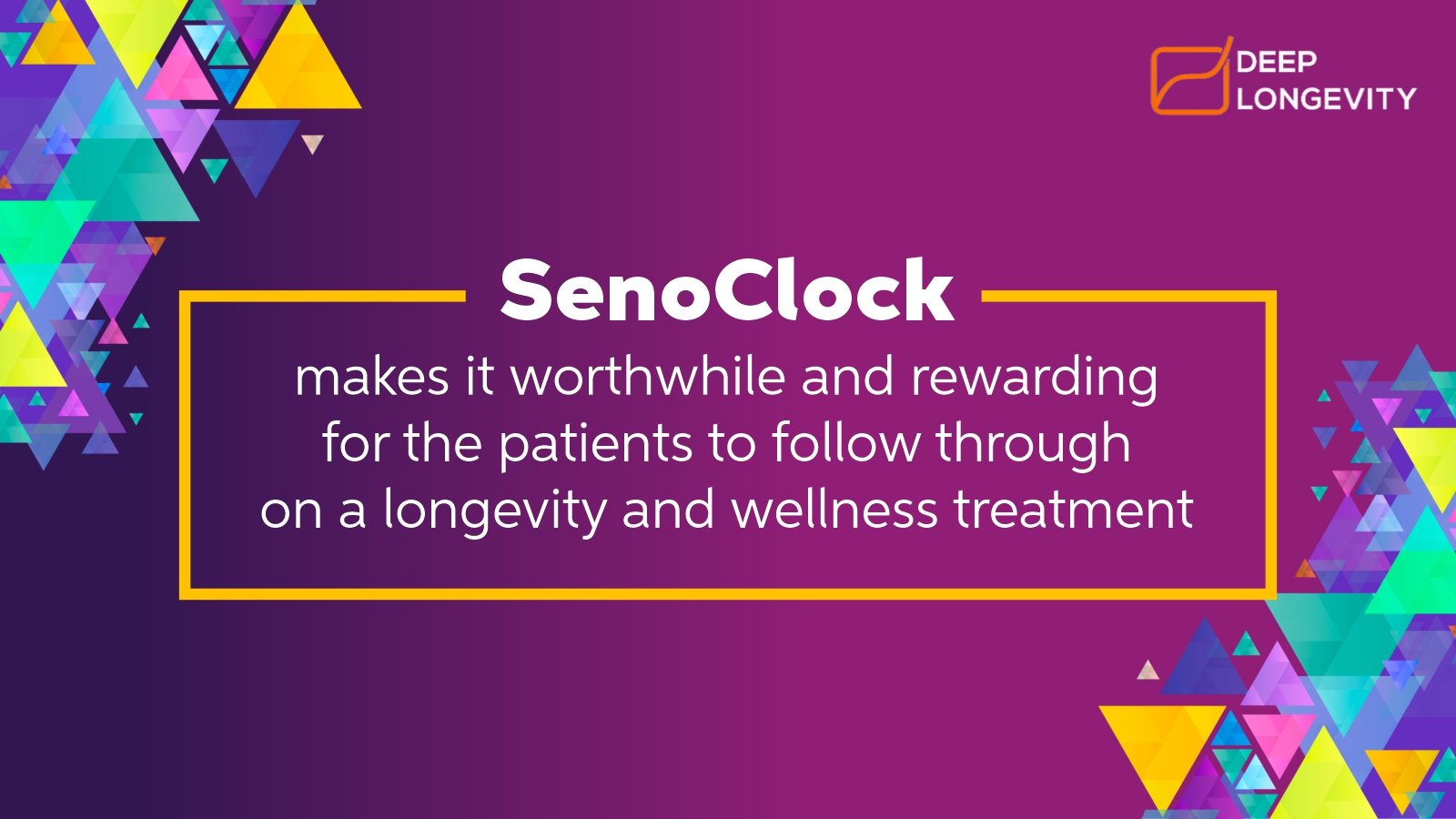
Unlike regular doctors who focus on specific diseases and medical conditions, longevity doctors have to deal with a host of issues that are otherwise unheard of in the medical profession. For example — too many parameters, a pure lack of standard diagnosis, patient motivation, result verification, and more. These issues not only affect the earlier diagnosis and treatment of probable aging-related diseases but also add to the confusion that surrounds longevity therapies and solutions, both on the part of the patients and medical professionals.
SenoClock solves these problems. It’s a SaaS-based platform that offers a portfolio of all the aging clocks developed by Deep Longevity. Doctors can use this platform for the diagnosis of current anomalies in a patient’s health as well as for the prediction of their future health concerns and possible solutions to avoid the same.
Let’s explore how it enables longevity doctors to help their patients live healthier, happier, and longer lives.
A new parameter that encompasses them all
Though, longevity doctors have a single goal to extend and preserve the healthy life of their patients. It quickly translates into the struggle to avoid every possible disease or sickness that might affect them.
With no standard diagnosis and parameters in place, it is nearly impossible for medical professionals to come to a consensus regarding the problem and possible interventions. In fact, it is very likely that a human won’t even pick up on the microscopic cues hidden among the numbers in multiple reports.
Aging clocks by Deep Longevity, which are available on SenoClock, help doctors and patients understand and analyze these standard reports by converting them into biological or psychological age.
It is not only straightforward to compare biological age with chronological age – and categorize the patients into slow or fast-ager groups, the detailed reports delivered by these aging clocks make it even easier to decide on possible interventions and therapies.
It is not only straightforward to compare biological age with chronological age – and categorize the patients into slow or fast-ager groups, the detailed reports delivered by these aging clocks make it even easier to decide on possible interventions and therapies.
Patient motivation: New goal, more life
Along with biological age, these aging clocks also predict the optimal age of a patient, i.e., the minimum possible biological age that can be achieved (with interventions available).
Longevity patients are not dealing with ongoing health issues, illness, discomfort, or pain. It doesn’t make sense for them to struggle so much over one or two parameters in their reports that deviate by a few numbers.
SenoClock, by converting these numbers into biological and optimal age, makes it worthwhile and rewarding for the patients to implement lifestyle changes and follow up on therapies. It gives them a new goal to strive for – their optimal age. If they can lower their biological age, even by a couple of years, it is a lot more beneficial and easier for them to continue the best practices.
Patients will also find it easier (and necessary) to get back on track whenever there is a slip-up and if their biological age shifts unexpectedly.
SenoClock may, in hindsight, also help longevity doctors to encourage more patients to undergo the diagnosis and take on preventive measures to improve their health prospects in the future.
Full transparency: Unearthing the real culprit – true biomarkers that affect the most
The next section of Blood Age and other reports that SenoClock avails will always include the different parameters that are used in the prediction. It lists exactly which biomarker adds how many years to a patient’s biological age. So the longevity doctor would know exactly what is affecting a patient the most and where to focus.
SenoClock eliminates all the speculations from the diagnosis and monitoring of longevity treatments. It reveals the causal factors and allows the doctors to recommend further diagnosis and future interventions that may protect a patient from unnecessary pain and procedures.
Thus, even if a patient’s biological age is somewhat less than the chronological age, the doctors will know exactly what to expect in the future. They cannot only intervene right away, they can also help their patients remove another year or two from their biological age.
These factors also go hand-in-hand with patient motivation. If you can show that lowering their cholesterol levels by a few points may take off up to two years from their biological age, it becomes much easier to explain and encourage them to avoid sugar and other unhealthy practices.
Individual patients, individual organs
Human body has a number of vital and necessary organs (and functions) that are imperative to normal human life. We cannot ignore them with an all-encompassing blood or microbiome test that predicts the biological age of a patient.
SenoClock offers a number of aging clocks that address the issue. For example — The Blood Age clock lists individual scores for different vital organs like the heart, kidneys, liver, and other glands (lipid profile). Mind Age measures the mental health and psychological well-being of a person. And microbiome-based aging clocks build different profiles that help longevity doctors better assess a patient’s current health and predict future health prospects.
The diagnosis once again not only informs the current status of the patient – but also allows for early-stage intervention and avoids disastrous possibilities. Life becomes a lot easier, and the impact on lifespan becomes negligible if you can detect the onslaught of diseases like diabetes early on – and start implementing lifestyle changes and other preventive therapies. The same goes for the other organs as well. If you can spot the slight deterioration in performance early on, it’s easier to undergo preventive measures and avoid the worst.
Quick intervention: More patients, better results, easier implementation
all that speculation out of the picture – and 100% digital implementation of SenoClock – longevity diagnosis becomes easier and blazing fast.
The platform allows doctors to download aging clock reports within minutes of uploading patient data, which saves both the appointment time and unnecessary waiting-time on the part of the patients. It’s also pretty easy to train professionals for the effective operation of SenoClock – and doesn’t take more than a 1-hour training seminar.
Most of these aging clocks utilize assessment-based questionnaires and simple blood test reports available globally to predict biological age and generate the reports. So doctors do not need to find new or specific labs to run these tests.
Longevity doctors can review more patients in less time and offer better services with precise results. By enabling doctors to attract and care for more patients – SenoClock helps them extend the lifespan of their patients at much higher scales, especially when estim With ated collectively.

If you want to implement SenoClock at your longevity clinic or hospital, request a demo call with our experts.
We’re more than ready to answer any questions or queries. There is also a free trial license available for advanced longevity clinics that want to implement the new age preventive technology.
As a word of caution – Even though all of these aging clocks have been validated and published in multiple peer-reviewed studies around the globe, these are not yet certified for clinical use. Professional expertise is still the first and foremost approach to medicine. The platform, SenoClock, and its aging clocks should never be used to automate medical decisions.

With that said – physicians may still employ these tools to provide their patients with a new longevity-focused perspective of health – and differentiate their practice in the marketplace. If you want to implement SenoClock at your hospital or clinic, please fill up the form.
